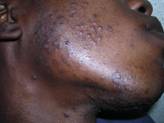What is pseudofolliculitis barbae?
It is an inflammatory reaction to the hair shaft entering the skin, most common in blacks who shave regularly.Who gets razor bumps?
About 50% of black males are said to be affected. Other races can also be affected. Though the condition is most commonly reported in men, women who remove unwanted hair also suffer from this condition.What causes razor bumps?
The condition is caused by both genetic factors and various hair removal methods.- Genetic factors:
- Curved hair follicles and curly hair
- A defect in the gene for the hair protein keratin 6hf
Hair removal methods may cause razor bumps by either creating a sharp hair tip that re-enters the skin away from the hair pore (extrafollicular penetration) or by the hair shaft breaking off at different lengths and piercing the follicle from within the skin (transfollicular penetration). An inflammatory reaction is then set up in response to the hair fragments lying in the skin. The following methods may cause razor bumps:
- Shaving
- Tweezing
- Waxing
- Electrolysis
What are the signs of pseudofolliculits barbae?
- Ingrown hairs
- Red, skin coloured or dark bumps
- Bumps containing pus

What are the complications of razor bumps?
- Pigmentary problems (darkening of the area most common)
- Scarring
- Abscess formation
- Psychological problems
Where do razor bumps occur?
Razor bumps are most common on the beard, however they have been reported to occur on the pubic area, legs and scalp.How can razor bumps be treated?
In the treatment of razor bumps, it is true to say that ‘prevention is better than cure’. Unfortunately though there is no cure it can be controlled by various measures.One suggestion has been to grow a beard to cure the disease. This approach is not cosmetically acceptable to many men, and of course to many women affected with this condition.
Treatment of razor bumps involves prevention of the bumps as well as treating existing bumps and their complications.
Prevention of razor bumps
- Laser hair removal is the best method of removing unwanted hair in individuals affected with this condition. The laser device is programmed to selectively target the pigment in the hair follicle, destroying it, while leaving the skin intact. There is an increased risk of skin damage is individuals with darker skin types because of greater amounts of pigment in the skin. However some lasers (e.g. Nd YAG) are designed to minimize this risk and have safely been used in all skin colours with great results. 10% to 20% of hairs are removed, with hairs becoming thinner, with each treatment. An average of 6 treatments, 4 to 8 weeks apart is usually required for satisfactory hair reduction. Long term studies are needed to check for true permanence of laser hair removal.- Electrical clippers are found by many to cause less bumps than razors. If one must shave it is important to avoid a close shave to help prevent razor bumps. The following is a guide to safer shaving methods:
- Brush hairs with polyester sponge before shaving
- Wash beard, use pre-shave cream or gel
- Avoid double and triple blade razors
- Shave in the direction of hair growth
- Do not pull the skin taut
- Use a sharp blade, rinse after each stroke
- Apply a cold compress after shaving, then a soothing aftershave preparation
- Clipping hairs with a small pair of facial scissors is an option for women with few unwanted hairs.
- Chemical depilatories (hair removal creams) are another option for hair removal. However, their major drawback is that many individuals find them too irritating to the skin. Bleaching creams may be used to camouflage hair instead of actually removing the hair.
- Electrolysis is a permanent method of hair removal but requires several sessions. It is operator dependent and can cause bumps and scarring. Waxing and tweezing also have the potential to cause bumps.
- Eflornithine hydrochloride (Vaniqa®) is a cream that slows the growth of hair and therefore can be used in combination with a hair removal method. It is marketed for women with unwanted facial hair.
- Anti-androgen drugs can be used in females who have hirsutism (male pattern hair growth e.g. beard hairs)
Treatment of bumps
- There are several treatment options to deal with razor bumps already present. They include:
- Moisturizers
- Retinoids
- Steroids
- Antibiotics
- Alpha-hydroxy acids
- Chemical peels
- Microdermabrasion
Treatment options for hyperpigmentation and scarring
Hyperpigmentation (darkening of skin): Pigment suppressing creams (hydroquinone and its combinations with retinoic acid and steroid creams, kojic acid, azelic acid etc), chemical peels, laserScarring: Topical and injectable steroids, silicone sheeting, surgery, dermabrasion, laser resurfacing, chemical peels, fillers.
Related post: Top best electric shaver for sensitive skin ... Read more in: best electric shaver
 How to buy
How to buy 

No comments:
Post a Comment